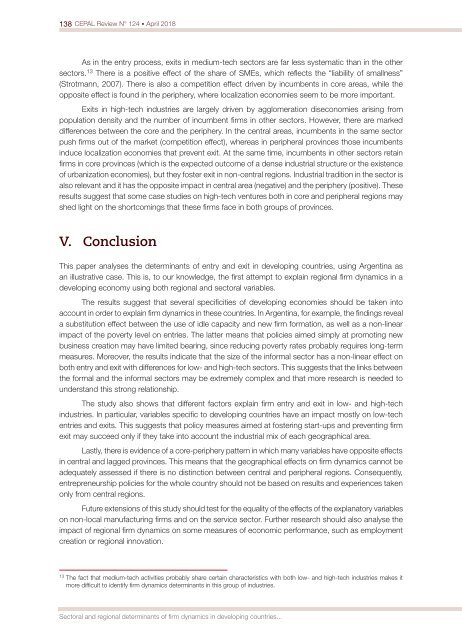CEPAL Review no. 124
April 2018
April 2018
You also want an ePaper? Increase the reach of your titles
YUMPU automatically turns print PDFs into web optimized ePapers that Google loves.
138 <strong>CEPAL</strong> <strong>Review</strong> N° <strong>124</strong> • April 2018<br />
As in the entry process, exits in medium-tech sectors are far less systematic than in the other<br />
sectors. 13 There is a positive effect of the share of SMEs, which reflects the “liability of smallness”<br />
(Strotmann, 2007). There is also a competition effect driven by incumbents in core areas, while the<br />
opposite effect is found in the periphery, where localization eco<strong>no</strong>mies seem to be more important.<br />
Exits in high-tech industries are largely driven by agglomeration diseco<strong>no</strong>mies arising from<br />
population density and the number of incumbent firms in other sectors. However, there are marked<br />
differences between the core and the periphery. In the central areas, incumbents in the same sector<br />
push firms out of the market (competition effect), whereas in peripheral provinces those incumbents<br />
induce localization eco<strong>no</strong>mies that prevent exit. At the same time, incumbents in other sectors retain<br />
firms in core provinces (which is the expected outcome of a dense industrial structure or the existence<br />
of urbanization eco<strong>no</strong>mies), but they foster exit in <strong>no</strong>n-central regions. Industrial tradition in the sector is<br />
also relevant and it has the opposite impact in central area (negative) and the periphery (positive). These<br />
results suggest that some case studies on high-tech ventures both in core and peripheral regions may<br />
shed light on the shortcomings that these firms face in both groups of provinces.<br />
V. Conclusion<br />
This paper analyses the determinants of entry and exit in developing countries, using Argentina as<br />
an illustrative case. This is, to our k<strong>no</strong>wledge, the first attempt to explain regional firm dynamics in a<br />
developing eco<strong>no</strong>my using both regional and sectoral variables.<br />
The results suggest that several specificities of developing eco<strong>no</strong>mies should be taken into<br />
account in order to explain firm dynamics in these countries. In Argentina, for example, the findings reveal<br />
a substitution effect between the use of idle capacity and new firm formation, as well as a <strong>no</strong>n-linear<br />
impact of the poverty level on entries. The latter means that policies aimed simply at promoting new<br />
business creation may have limited bearing, since reducing poverty rates probably requires long-term<br />
measures. Moreover, the results indicate that the size of the informal sector has a <strong>no</strong>n-linear effect on<br />
both entry and exit with differences for low- and high-tech sectors. This suggests that the links between<br />
the formal and the informal sectors may be extremely complex and that more research is needed to<br />
understand this strong relationship.<br />
The study also shows that different factors explain firm entry and exit in low- and high-tech<br />
industries. In particular, variables specific to developing countries have an impact mostly on low-tech<br />
entries and exits. This suggests that policy measures aimed at fostering start-ups and preventing firm<br />
exit may succeed only if they take into account the industrial mix of each geographical area.<br />
Lastly, there is evidence of a core-periphery pattern in which many variables have opposite effects<br />
in central and lagged provinces. This means that the geographical effects on firm dynamics can<strong>no</strong>t be<br />
adequately assessed if there is <strong>no</strong> distinction between central and peripheral regions. Consequently,<br />
entrepreneurship policies for the whole country should <strong>no</strong>t be based on results and experiences taken<br />
only from central regions.<br />
Future extensions of this study should test for the equality of the effects of the explanatory variables<br />
on <strong>no</strong>n-local manufacturing firms and on the service sector. Further research should also analyse the<br />
impact of regional firm dynamics on some measures of eco<strong>no</strong>mic performance, such as employment<br />
creation or regional in<strong>no</strong>vation.<br />
13<br />
The fact that medium-tech activities probably share certain characteristics with both low- and high-tech industries makes it<br />
more difficult to identify firm dynamics determinants in this group of industries.<br />
Sectoral and regional determinants of firm dynamics in developing countries...


















